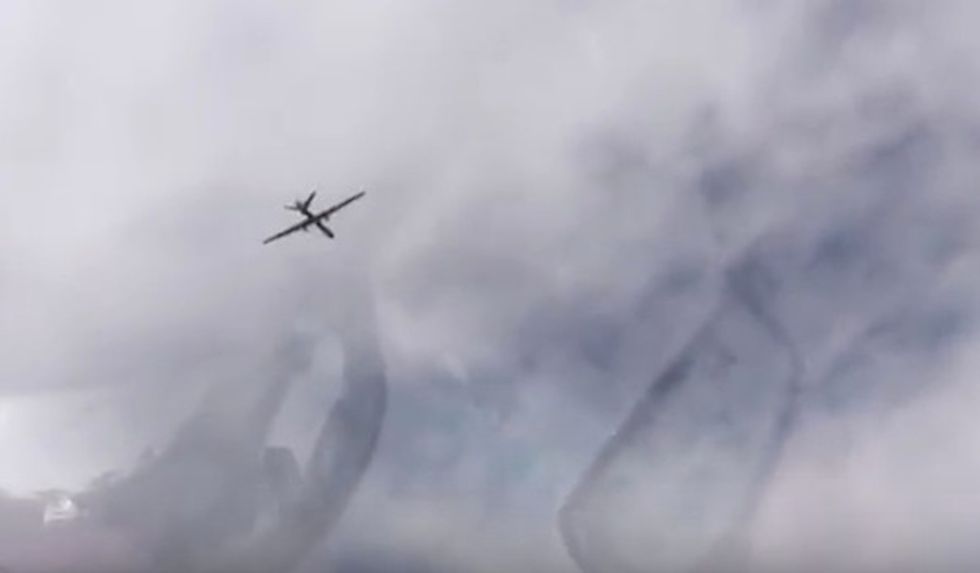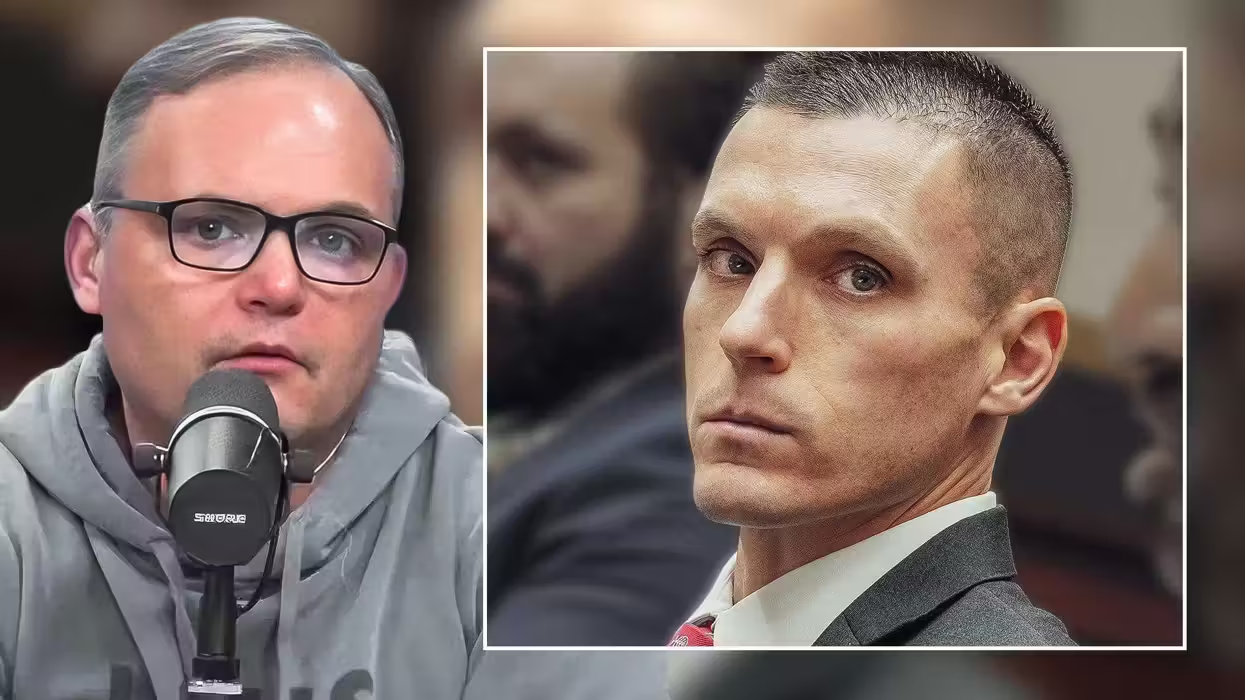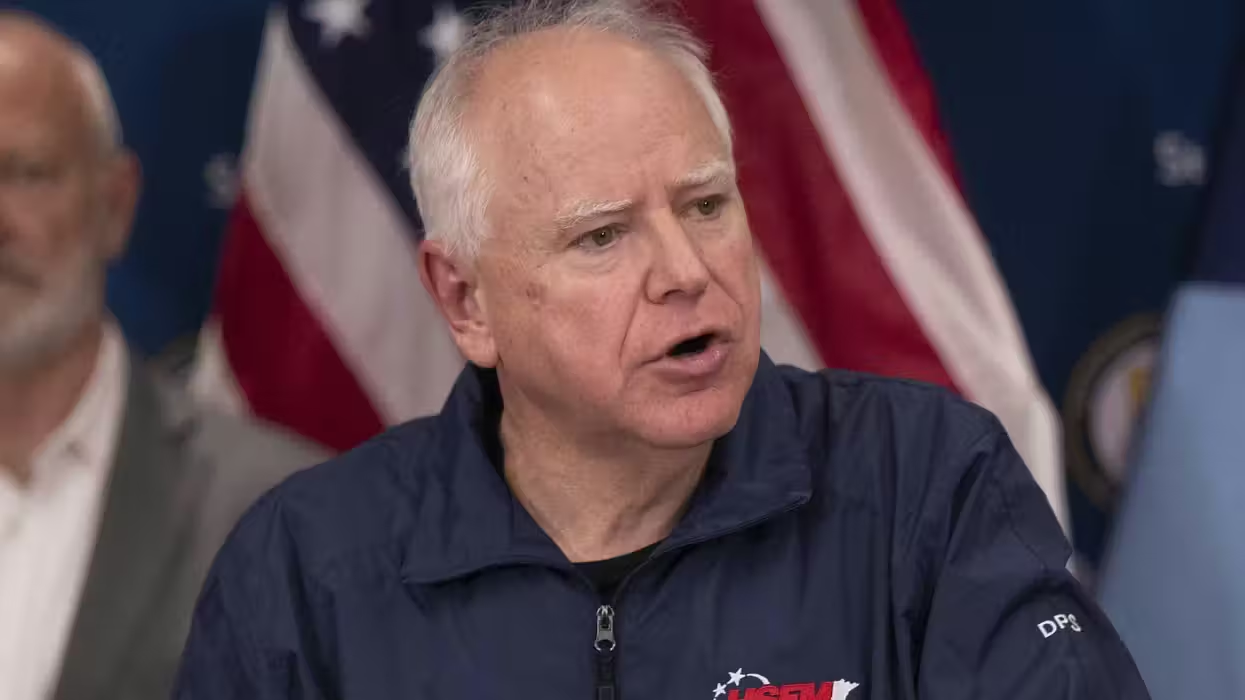
© 2026 Blaze Media LLC. All rights reserved.
Close Encounter: Russian Pilot Watches a U.S. Drone Make a Flyby Overhead
October 21, 2015
The two countries reached an agreement for "maintaining professional airmanship" this week.
A video released by the Russian Defense Ministry this week taken by one of its own pilots in Syria shows a U.S. drone make a pass above.
"Recently, the presence of different aircraft in the air space of Syria has increased," the ministry stated in a news release Tuesday. "These are civil airliners, military transport aircraft, combat aircraft, unmanned aerial vehicles of different size including strike ones."

While Russia said its air group "coordinates every flight with the Syrian service for air traffic control," the ministry went on to state that "all the other manned and unmanned aircraft with the exception of the civil airliners are present in the Syrian air space without any accordance and with their transponders switched-off."
"It is not infrequent that there are over 30 aircraft in one area at the same time. Undoubtedly, all that creates risks for aviation in the skies over Syria," the news release stated.
Watch one such close encounter filmed by a Russian pilot of what Popular Science identified as a U.S. MQ-9 Reaper drone:
ABC News aviation consultant Stephen Ganyard described this as a "controlled intercept, very routine," the news outlet reported.
"These are the kinds of intercepts that all fighter pilots practice," he told ABC.
On Tuesday, the U.S. and Russia reached an agreement to minimize the risk of air collisions between military aircraft over Syria.
A Russian defense official in Moscow said the "memorandum of understanding" suggests a potential for U.S.-Russian counterterrorism cooperation, but U.S. officials said it was a narrow arrangement that does not lessen Washington's concern about the Russian military campaign.
There is no plan to establish zones of cooperation in the parallel air campaigns or to share intelligence or target information in Syria, Pentagon spokesman Peter Cook said.
The Pentagon has cited several instances when Russian aircraft came too close to U.S. warplanes over Syria in recent weeks. More broadly, Washington has complained that instead of hitting Islamic State fighters, Russian airstrikes are mostly targeting rebel forces fighting the Syrian government. Russia also deployed ground troops and land-based weaponry, including multiple-launch rocket systems, in support of the Syrian government.
The arrangement "does nothing to assuage our concerns about Russian military activities in Syria," State Department spokesman John Kirby said.
Cook said Gen. Lloyd Austin, commander of U.S. Central Command, signed for the U.S. side Tuesday. At a Pentagon news conference, Cook gave a broad description of the document but said the U.S. had accepted a Russian request that the text be kept secret.
After several rounds of talks that began more than a week ago, the two sides agreed to a number of air safety protocols including "maintaining professional airmanship" and the use of specific aircraft communications frequencies, Cook said. They agreed to keep a "safe distance" between aircraft, Cook said, but he would not say whether specific distances were written into the memo.
The two sides also agreed to establish a "communication line on the ground" as a backup of military-to-military communication, Cook said, although he would not say whether this would be a telephone line or where it would be located. A U.S.-Russia working group will be formed to deal with any implementation issues that arise, he added.
The discussions that led to the protocols "do not constitute U.S. cooperation or support for Russia's policy and actions in Syria," Cook said. "In fact, far from it, we continue to believe that Russia's strategy in Syria is counterproductive, and their support for the Assad regime will only make Syria's civil war worse." He was referring to Syrian President Bashar Assad, whom the U.S. says is an illegitimate leader and must leave office.
In Moscow, Russian Deputy Defense Minister Anatoly Antonov said in a statement carried by Russian news agencies that signing the memorandum was a positive step that has "important practical meaning."
"The memorandum contains a complex of rules and restrictions aimed at preventing incidents between Russian and U.S. aircraft," Antonov said, adding that Russian and U.S. military officials will set up round-the-clock communications channels and "determine the mechanism of interaction, including mutual assistance in crisis situations."
"The Americans have promised to get the agreed rules to all participants of the anti-IS coalition they lead, so that their pilots proceed from those agreements," he said, referring to the U.S. coalition that includes Australia, Bahrain, Canada, France, Jordan, Saudi Arabia, Turkey and the United Arab Emirates.
Antonov added that the memorandum "shows a big potential for cooperation between Russia and the U.S., including in the fight against terrorism, which we are ready to expand and deepen."
—
The Associated Press contributed to this report.
Want to leave a tip?
We answer to you. Help keep our content free of advertisers and big tech censorship by leaving a tip today.
Want to join the conversation?
Already a subscriber?
more stories
Sign up for the Blaze newsletter
By signing up, you agree to our Privacy Policy and Terms of Use, and agree to receive content that may sometimes include advertisements. You may opt out at any time.
Related Content
© 2026 Blaze Media LLC. All rights reserved.
Get the stories that matter most delivered directly to your inbox.
By signing up, you agree to our Privacy Policy and Terms of Use, and agree to receive content that may sometimes include advertisements. You may opt out at any time.






